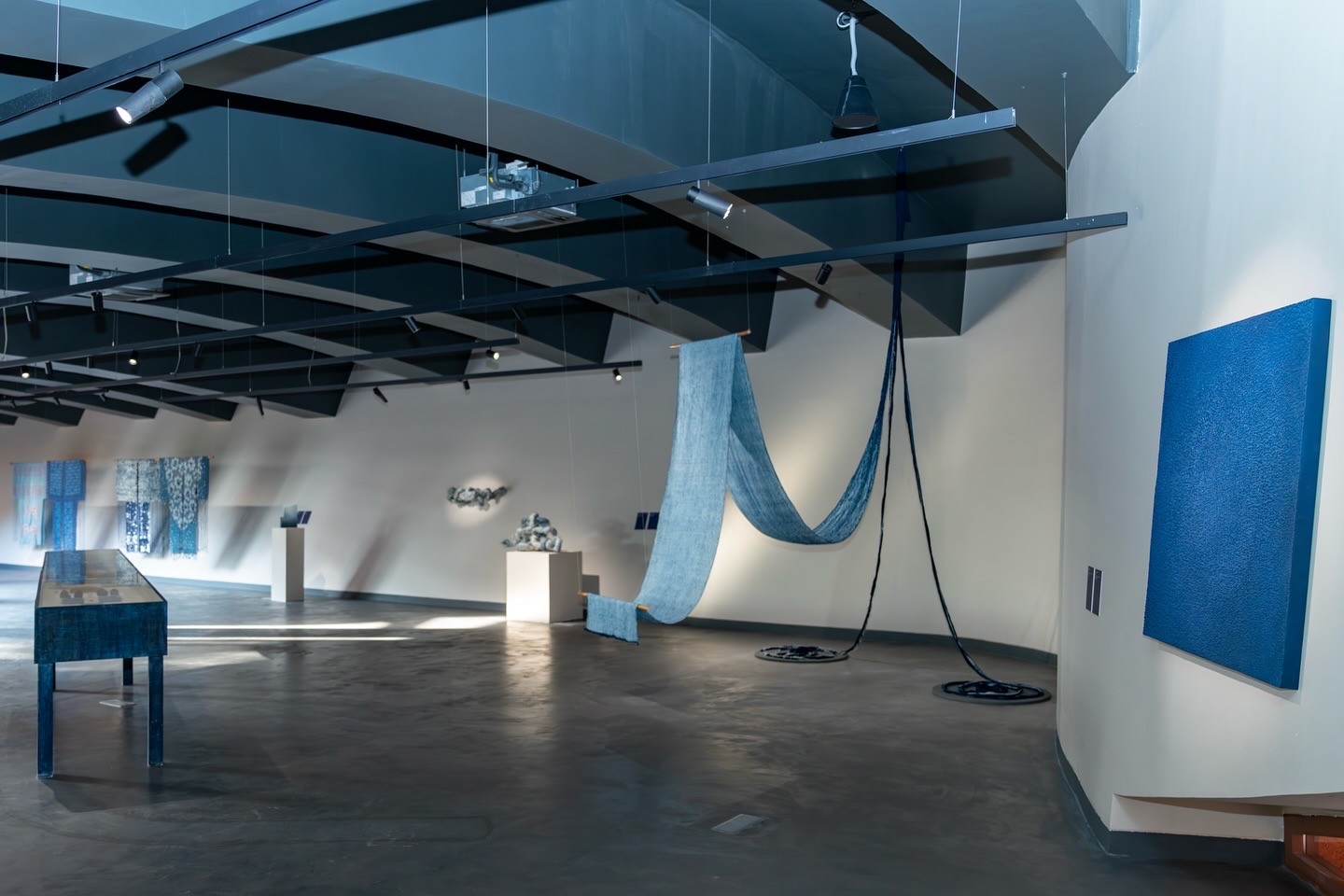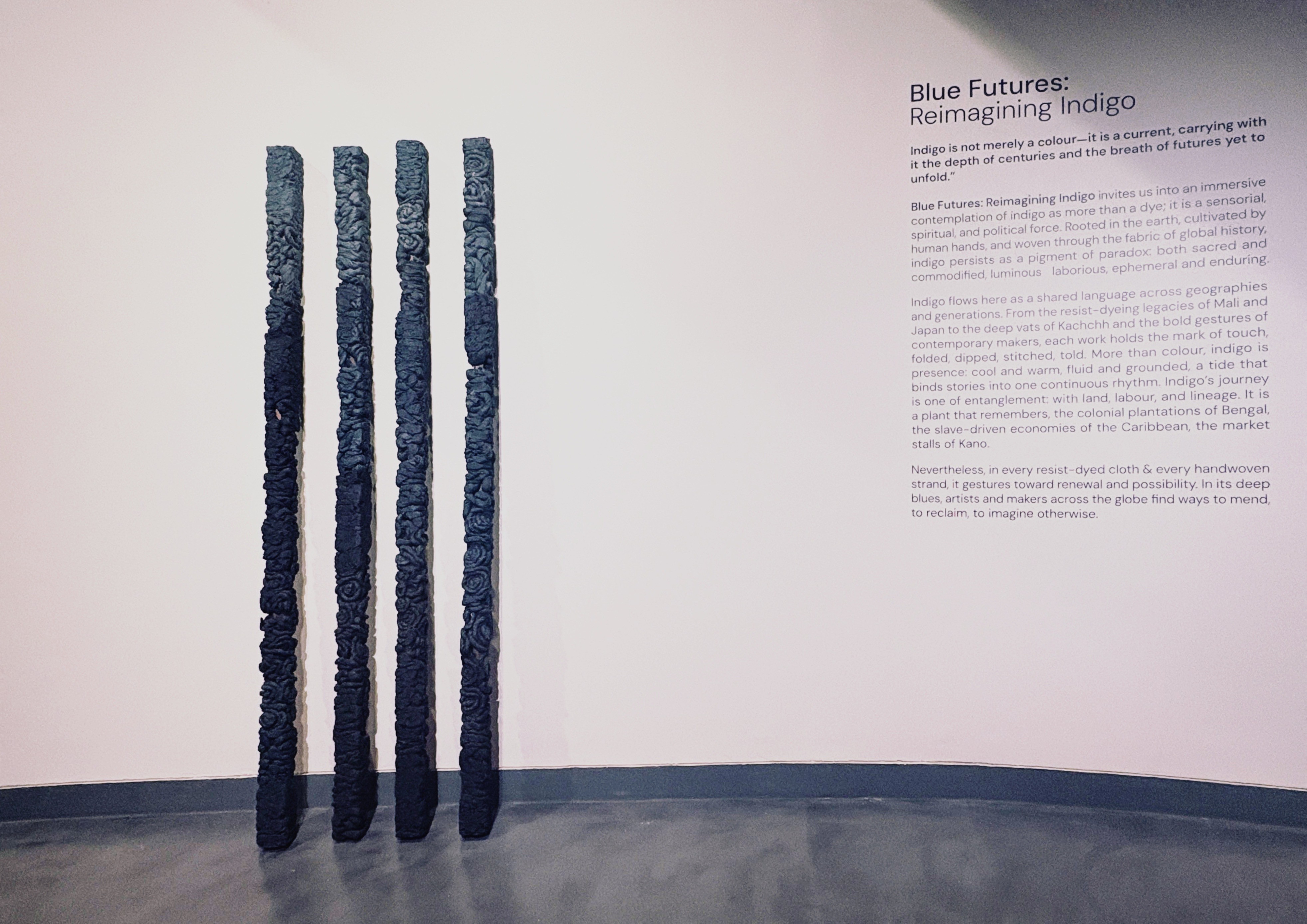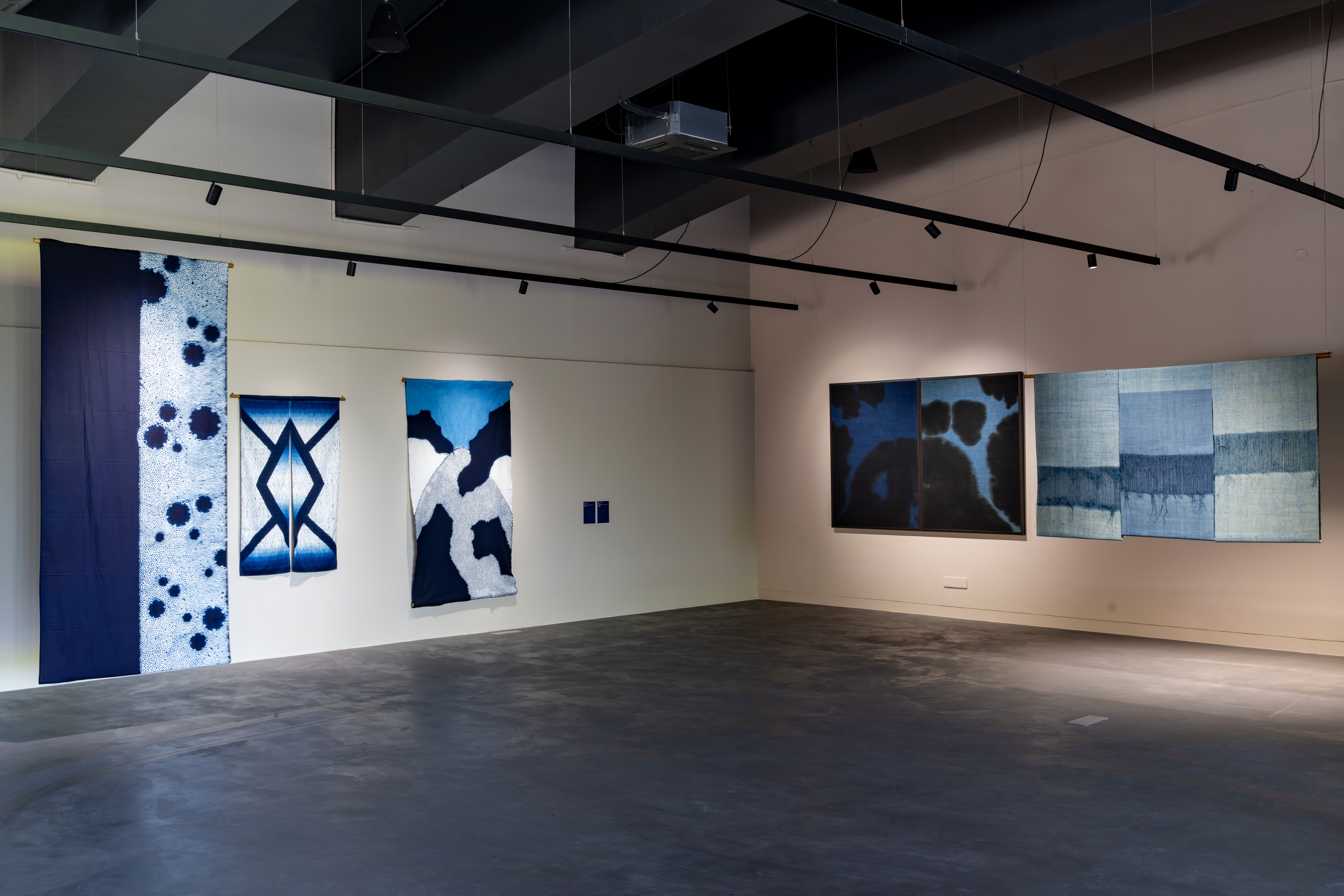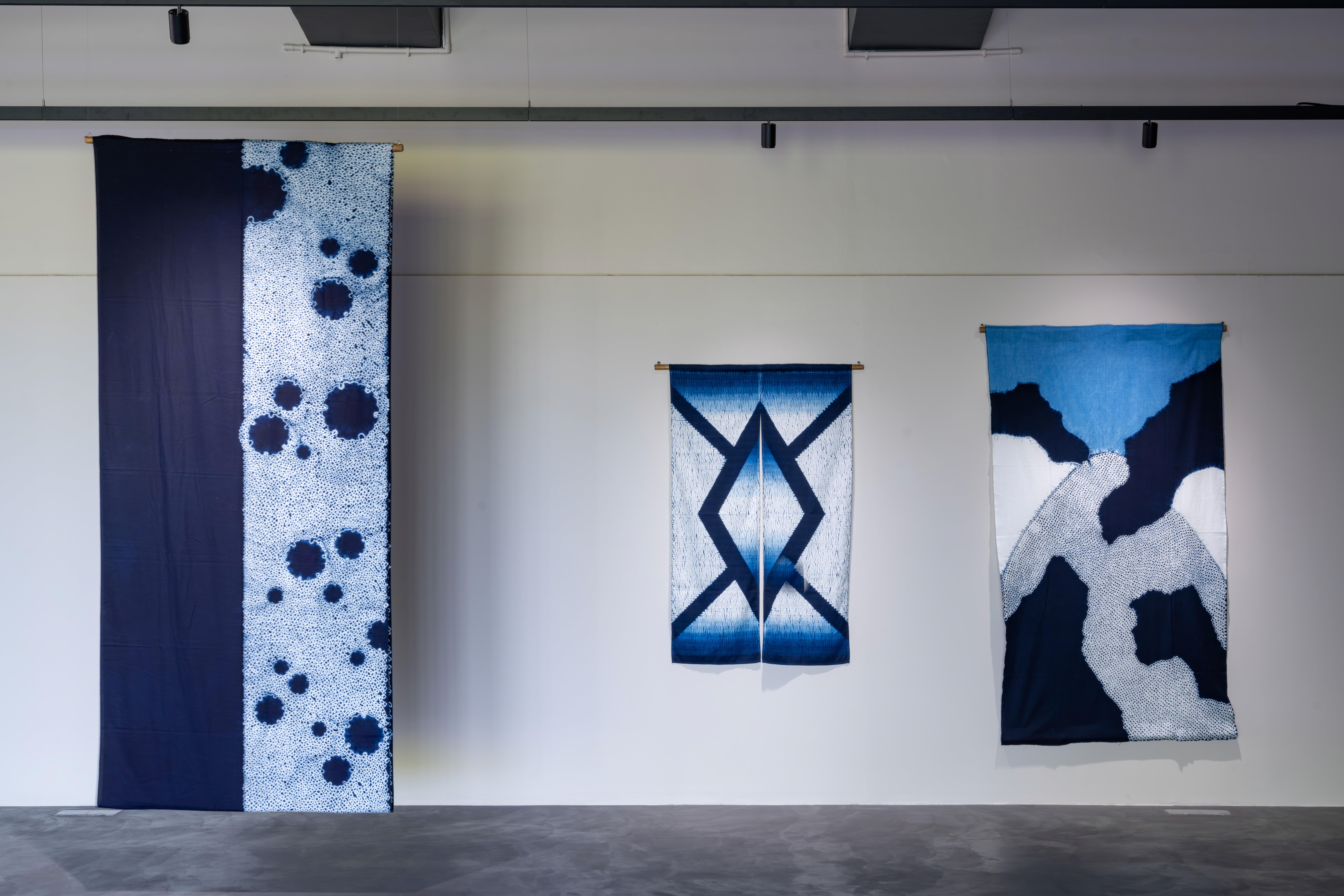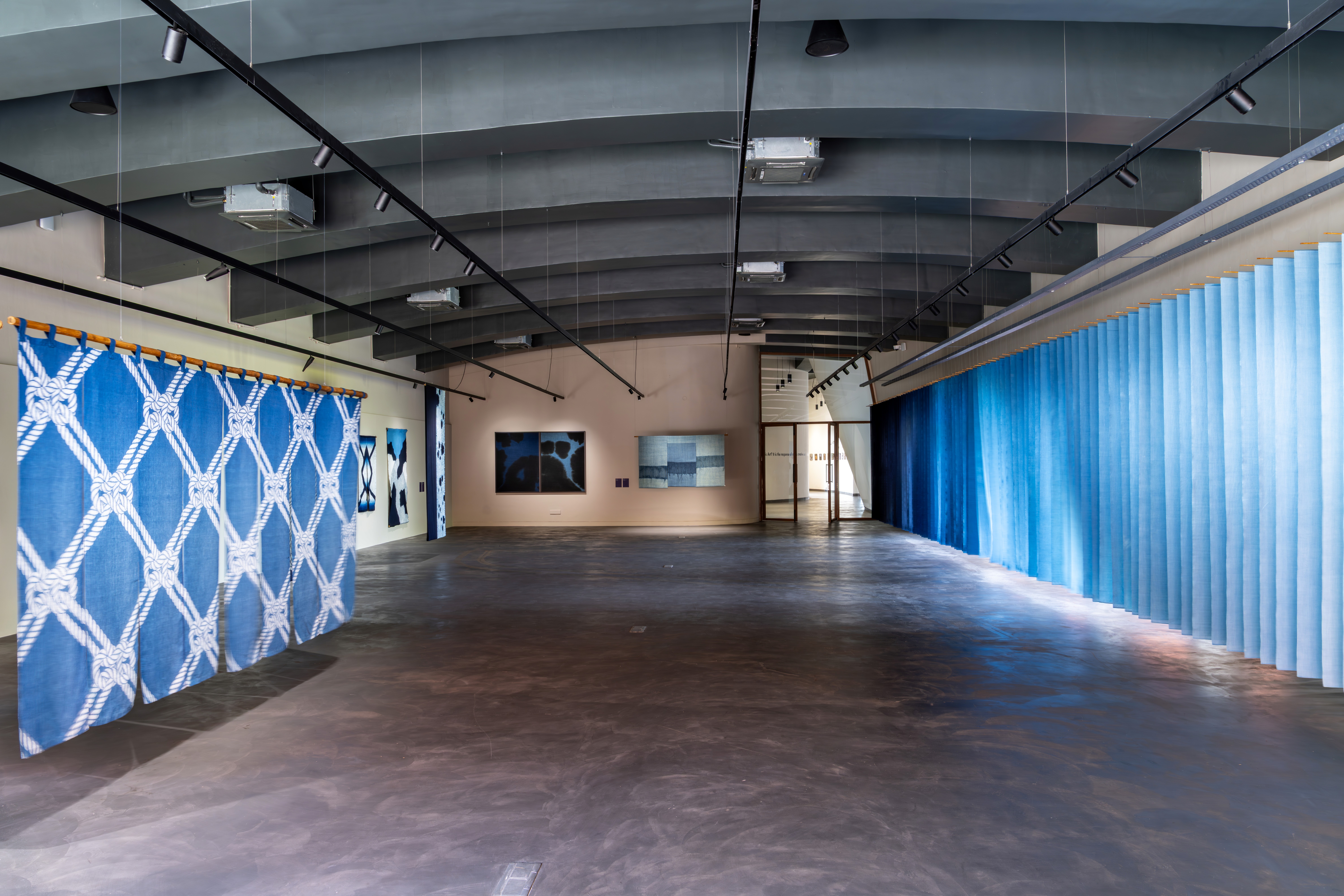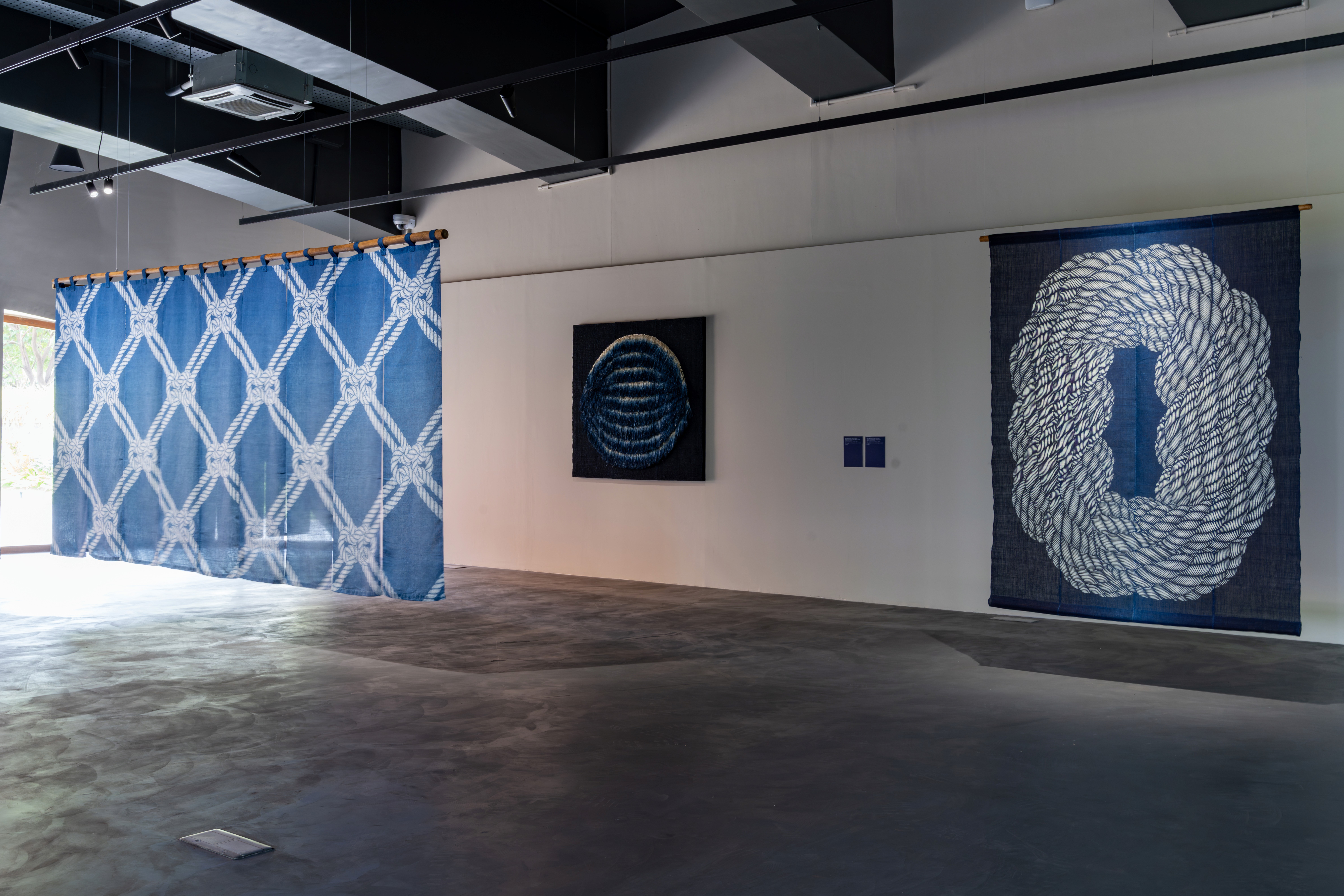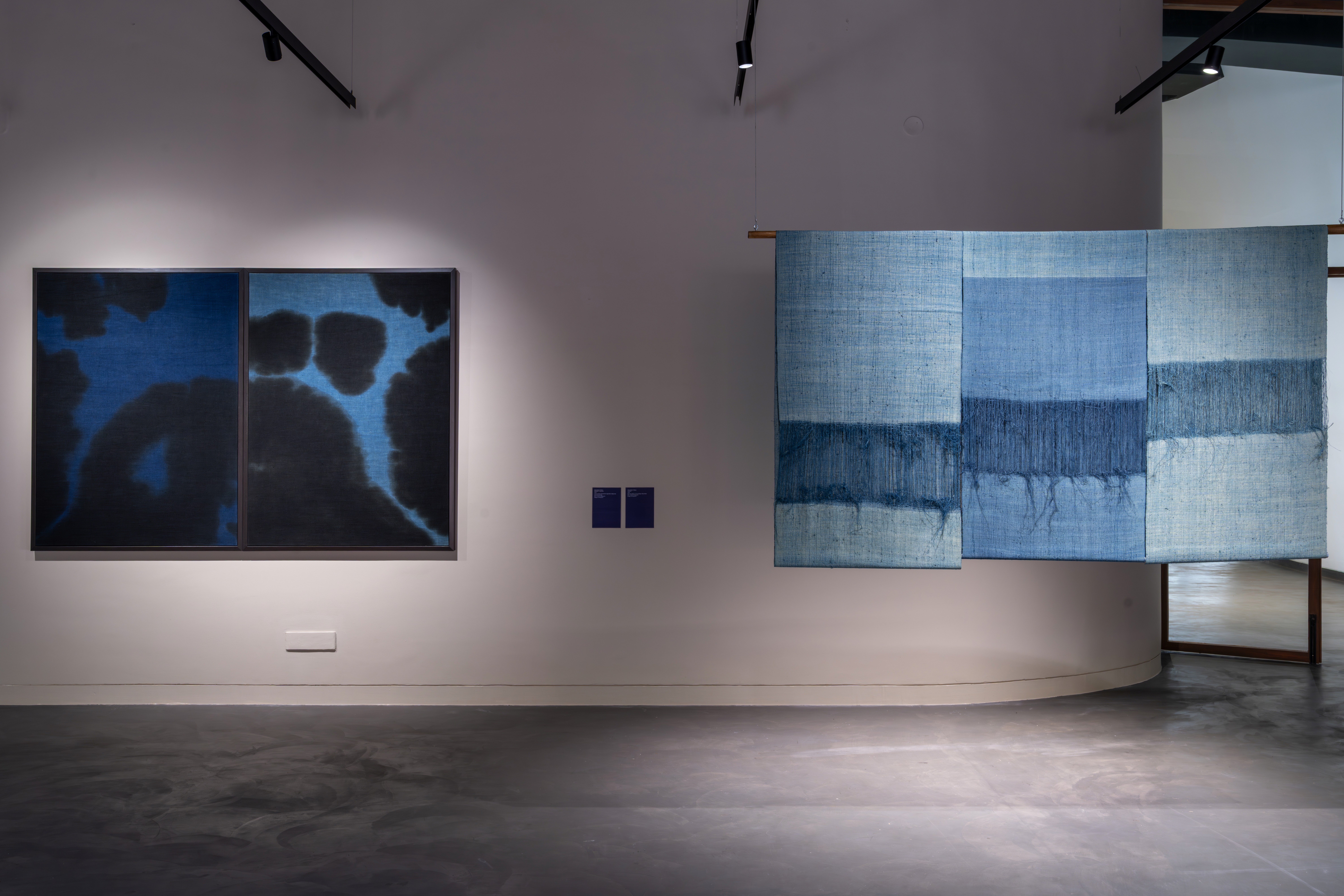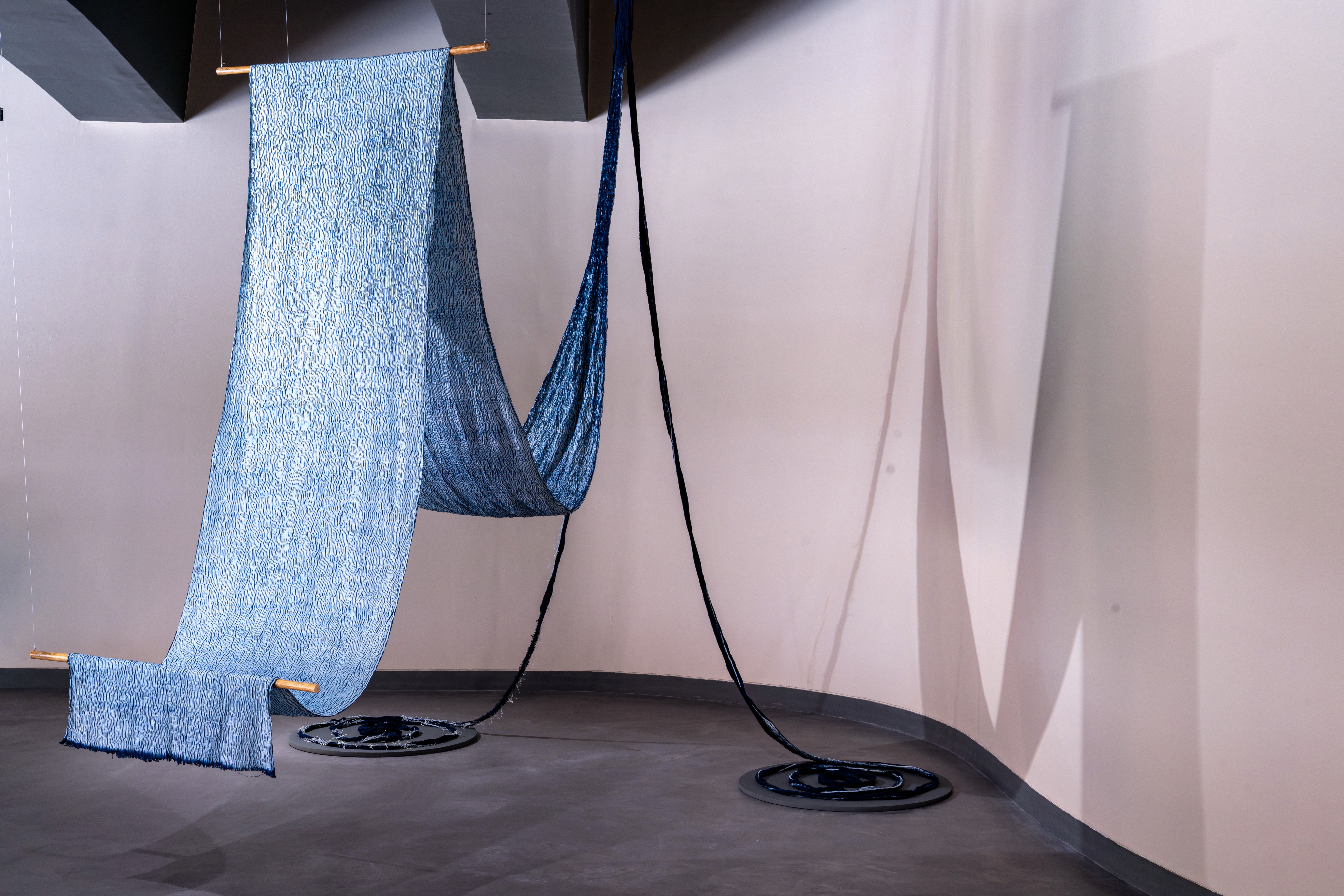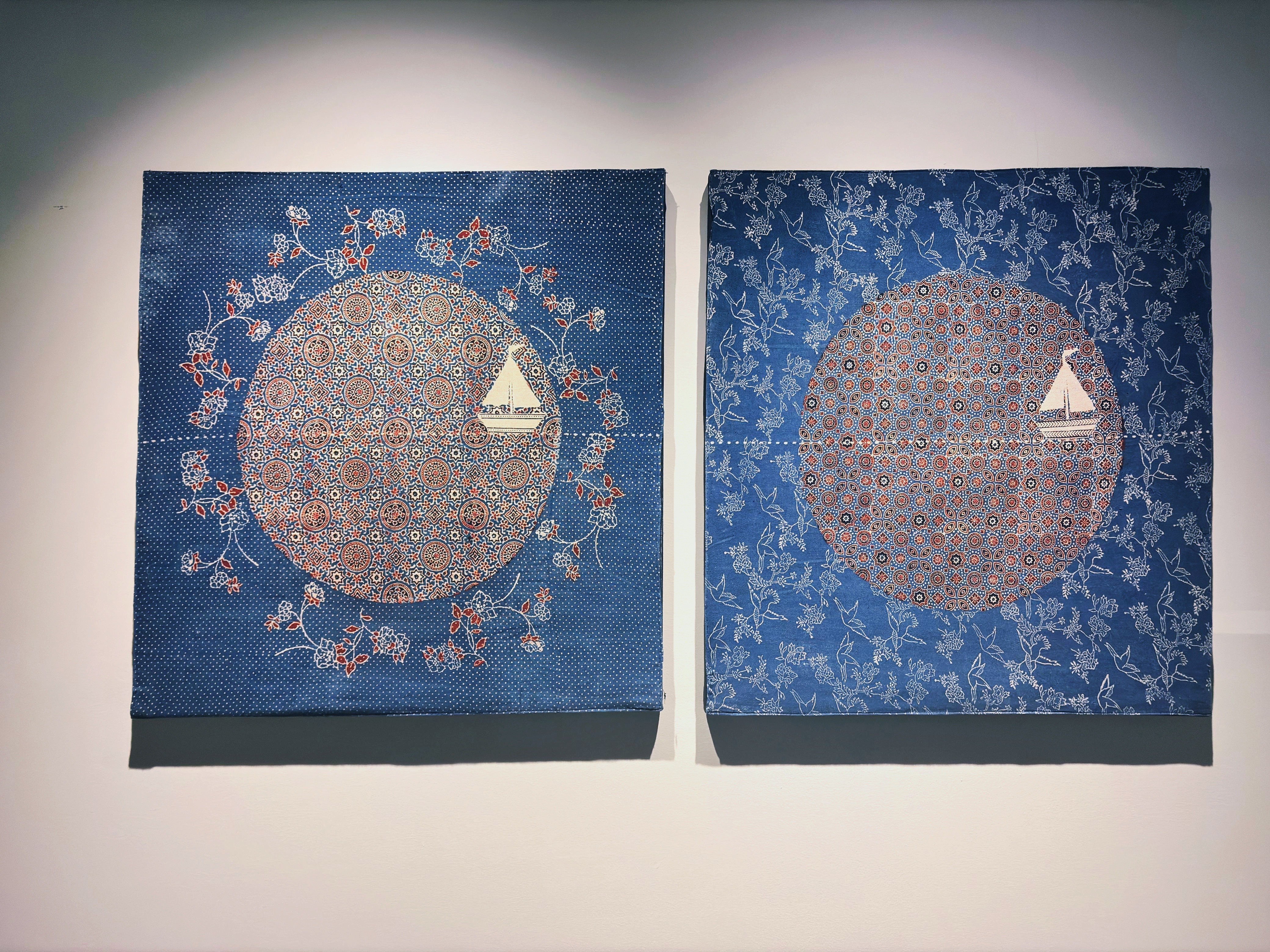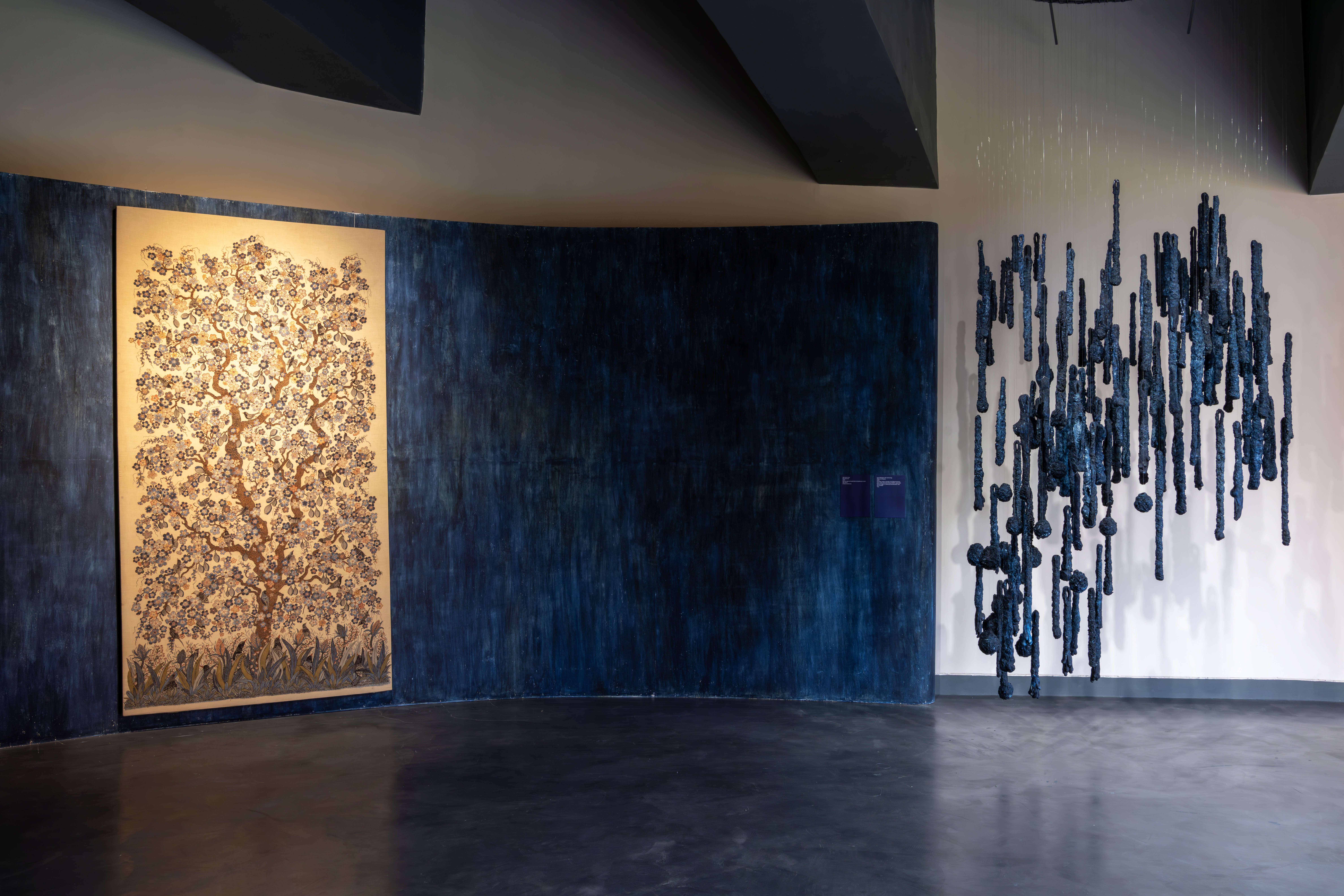Current Exhibition
Blue Futures: Reimagining Indigo
3rd November 2025 - 28th January 2026
Exhibition Timings- 3pm to 7pm
For guided walks please email at info@hampiartlabs.com
3rd November 2025 - 28th January 2026
Exhibition Timings- 3pm to 7pm
For guided walks please email at info@hampiartlabs.com
"Indigo is not merely a colour - it is a current, carrying with it the depth of centuries and the breath of futures yet to unfold".
Blue Futures: Reimagining Indigo invites us into an immersive contemplation of indigo as more than a dye; it is a sensorial, spiritual, and political force. Rooted in the earth, cultivated by human hands, and woven through the fabric of global history, indigo persists as a pigment of paradox: both sacred and commodified, luminous and laborious, ephemeral and enduring. Indigo flows here as a shared language across geographies and generations. From the resist-dyeing legacies of Mali and Japan to the deep vats of Kachchh and the bold gestures of contemporary makers, each work holds the mark of touch, folded, dipped, stitched, told. More than colour, indigo is presence: cool and warm, fluid and grounded, a tide that binds stories into one continuous rhythm. Indigo’s journey is one of entanglement: with land, labour, and lineage. It is a plant that remembers, the colonial plantations of Bengal, the slave-driven economies of the Caribbean, the market stalls of Kano. Nevertheless, in every resist-dyed cloth & every handwoven strand, it gestures toward renewal and possibility. In its deep blues, artists and makers across the globe find ways to mend, to reclaim, to imagine otherwise.
This exhibition asks: What can a colour remember? What futures are possible when we listen to its shade? As one moves through the space, the audience is invited to slow down, trace the threads, and inhabit the rhythm of indigo, not as an artefact but as a living, breathing archive. It is a practice of attention, of care, and of co-creation.
Aboubakar Fofana | Ajit Kumar Das | Alwar Balasubramaniam | Bappaditya Biswas | Buaisou Japan Kakuo Kaji / Buaisou Japan | Kavin Mehta | Manish Nai Savia Mahajan with Ashok Sijju | Shelly Jyoti | Takuma / SlowFabric | Upendra Ram | Vyom Mehta
Curation: Meera Curam
Project Management: Siddhant Beriwal
Event Management: Severina Fernandes
Head Office Coordination: Urshila Mehta
Art Logistics: Amit Lodh
Exhibition Design: Reha Sodhi and Rajat Sodhi
Graphic Design: Tanya Shah
Hampi Art Labs team: Dilip Rathod, Pooja Ranvir, Ramya E M and Anisha Jacquilin Toppo
Image credit for Indigo process: Shovan Gandhi
With deep appreciation to Parmeet Kaur Tesson for her creation of a special indigo dye that enriches the exhibition wall.
Special thanks to Mrs. Jayshree Lalbhai and the Indigo Art Museum.
"Indigo is not merely a colour - it is a current, carrying with it the depth of centuries and the breath of futures yet to unfold".
Blue Futures: Reimagining Indigo invites us into an immersive contemplation of indigo as more than a dye; it is a sensorial, spiritual, and political force. Rooted in the earth, cultivated by human hands, and woven through the fabric of global history, indigo persists as a pigment of paradox: both sacred and commodified, luminous and laborious, ephemeral and enduring. Indigo flows here as a shared language across geographies and generations. From the resist-dyeing legacies of Mali and Japan to the deep vats of Kachchh and the bold gestures of contemporary makers, each work holds the mark of touch, folded, dipped, stitched, told. More than colour, indigo is presence: cool and warm, fluid and grounded, a tide that binds stories into one continuous rhythm. Indigo’s journey is one of entanglement: with land, labour, and lineage. It is a plant that remembers, the colonial plantations of Bengal, the slave-driven economies of the Caribbean, the market stalls of Kano. Nevertheless, in every resist-dyed cloth & every handwoven strand, it gestures toward renewal and possibility. In its deep blues, artists and makers across the globe find ways to mend, to reclaim, to imagine otherwise.
This exhibition asks: What can a colour remember? What futures are possible when we listen to its shade? As one moves through the space, the audience is invited to slow down, trace the threads, and inhabit the rhythm of indigo, not as an artefact but as a living, breathing archive. It is a practice of attention, of care, and of co-creation.
Aboubakar Fofana | Ajit Kumar Das | Alwar Balasubramaniam | Bappaditya Biswas | Buaisou Japan Kakuo Kaji / Buaisou Japan | Kavin Mehta | Manish Nai Savia Mahajan with Ashok Sijju | Shelly Jyoti | Takuma / SlowFabric | Upendra Ram | Vyom Mehta
Curation: Meera Curam
Project Management: Siddhant Beriwal
Event Management: Severina Fernandes
Head Office Coordination: Urshila Mehta
Art Logistics: Amit Lodh
Exhibition Design: Reha Sodhi and Rajat Sodhi
Graphic Design: Tanya Shah
Hampi Art Labs team: Dilip Rathod, Pooja Ranvir, Ramya E M and Anisha Jacquilin Toppo
Image credit for Indigo process: Shovan Gandhi
With deep appreciation to Parmeet Kaur Tesson for her creation of a special indigo dye that enriches the exhibition wall.
Special thanks to Mrs. Jayshree Lalbhai and the Indigo Art Museum.
"Indigo is not merely a colour - it is a current, carrying with it the depth of centuries and the breath of futures yet to unfold".
Blue Futures: Reimagining Indigo invites us into an immersive contemplation of indigo as more than a dye; it is a sensorial, spiritual, and political force. Rooted in the earth, cultivated by human hands, and woven through the fabric of global history, indigo persists as a pigment of paradox: both sacred and commodified, luminous and laborious, ephemeral and enduring. Indigo flows here as a shared language across geographies and generations. From the resist-dyeing legacies of Mali and Japan to the deep vats of Kachchh and the bold gestures of contemporary makers, each work holds the mark of touch, folded, dipped, stitched, told. More than colour, indigo is presence: cool and warm, fluid and grounded, a tide that binds stories into one continuous rhythm. Indigo’s journey is one of entanglement: with land, labour, and lineage. It is a plant that remembers, the colonial plantations of Bengal, the slave-driven economies of the Caribbean, the market stalls of Kano. Nevertheless, in every resist-dyed cloth & every handwoven strand, it gestures toward renewal and possibility. In its deep blues, artists and makers across the globe find ways to mend, to reclaim, to imagine otherwise.
This exhibition asks: What can a colour remember? What futures are possible when we listen to its shade? As one moves through the space, the audience is invited to slow down, trace the threads, and inhabit the rhythm of indigo, not as an artefact but as a living, breathing archive. It is a practice of attention, of care, and of co-creation.
Aboubakar Fofana | Ajit Kumar Das | Alwar Balasubramaniam | Bappaditya Biswas | Buaisou Japan Kakuo Kaji / Buaisou Japan | Kavin Mehta | Manish Nai Savia Mahajan with Ashok Sijju | Shelly Jyoti | Takuma / SlowFabric | Upendra Ram | Vyom Mehta
Curation: Meera Curam
Project Management: Siddhant Beriwal
Event Management: Severina Fernandes
Head Office Coordination: Urshila Mehta
Art Logistics: Amit Lodh
Exhibition Design: Reha Sodhi and Rajat Sodhi
Graphic Design: Tanya Shah
Hampi Art Labs team: Dilip Rathod, Pooja Ranvir, Ramya E M and Anisha Jacquilin Toppo
Image credit for Indigo process: Shovan Gandhi
With deep appreciation to Parmeet Kaur Tesson for her creation of a special indigo dye that enriches the exhibition wall.
Special thanks to Mrs. Jayshree Lalbhai and the Indigo Art Museum.


JSW Foundation is the social development arm of JSW Group, one of India’s leading business houses. It has a long track record and a rich legacy of empowering rural communities to enrich their lives since the last three decades. The Foundation’s focus areas are Education, Health and nutrition, Skill Development, Rural BPO, Environment & Water, Sports Art, and heritage. Through a strong field presence, it operates across 33 districts in 14 Indian States with priority on communities around JSW’s plant & port locations.
Privacy Policy | Terms Of Use | © 2023 Hampi Art Labs. All Rights Reserved.


JSW Foundation is the social development arm of JSW Group, one of India’s leading business houses. It has a long track record and a rich legacy of empowering rural communities to enrich their lives since the last three decades. The Foundation’s focus areas are Education, Health and nutrition, Skill Development, Rural BPO, Environment & Water, Sports Art, and heritage. Through a strong field presence, it operates across 33 districts in 14 Indian States with priority on communities around JSW’s plant & port locations.
Privacy Policy | Terms Of Use | © 2023 Hampi Art Labs. All Rights Reserved.


JSW Foundation is the social development arm of JSW Group, one of India’s leading business houses. It has a long track record and a rich legacy of empowering rural communities to enrich their lives since the last three decades. The Foundation’s focus areas are Education, Health and nutrition, Skill Development, Rural BPO, Environment & Water, Sports Art, and heritage. Through a strong field presence, it operates across 33 districts in 14 Indian States with priority on communities around JSW’s plant & port locations.
Privacy Policy | Terms Of Use | © 2023 Hampi Art Labs. All Rights Reserved.
